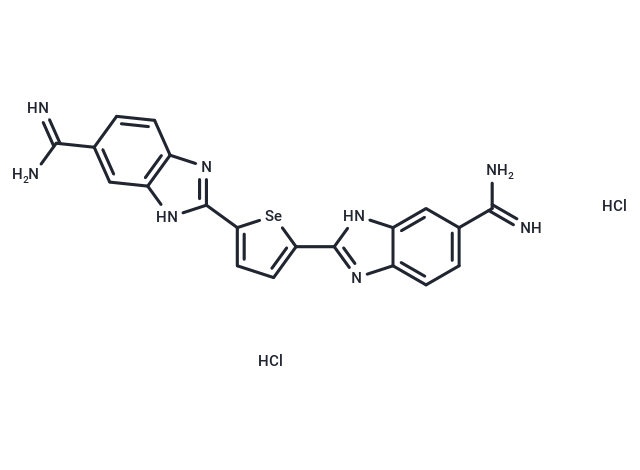Shopping Cart
- Remove All
 Your shopping cart is currently empty
Your shopping cart is currently empty

DB1976 dihydrochloride (DB1976 2HCl) , a transcription factor PU.1 inhibitor with potential anti-inflammatory activity, slowed down inflammation and fibrosis and improved glucose homeostasis and dyslipidemia in mice in in vivo experiments.DB1976 dihydrochloride promotes apoptosis and may be used in studies of metabolic dysfunction and non-alcoholic steatohepatitis.

| Pack Size | Price | Availability | Quantity |
|---|---|---|---|
| 5 mg | 370 € | 1-2 weeks | |
| 25 mg | 1.263 € | 1-2 weeks | |
| 50 mg | 1.653 € | 1-2 weeks | |
| 100 mg | 2.375 € | 1-2 weeks |
| Description | DB1976 dihydrochloride (DB1976 2HCl) , a transcription factor PU.1 inhibitor with potential anti-inflammatory activity, slowed down inflammation and fibrosis and improved glucose homeostasis and dyslipidemia in mice in in vivo experiments.DB1976 dihydrochloride promotes apoptosis and may be used in studies of metabolic dysfunction and non-alcoholic steatohepatitis. |
| Targets&IC50 | PU.1 URE–/–AML cells:105 μM, PU.1-negative HEK293 cells:2.4 μM, Hematopoietic cells:334 μM, PU.1:10 nM |
| In vitro | DB1976 dihydrochloride , a classic heterocyclic dication with strong affinity and selectivity for AT-rich sequences commonly found in cognate DNA binding sites for PU.1[3], inhibits PU.1-dependent transactivation of the reporter in a dose-dependent manner with an IC50 value of 2.4 μM in PU.1-negative HEK293 cells[2]. Treatment with DB1976 dihydrochloride leads to a profound decrease in the growth of PU.1 URE–/– AML cells (IC50 of 105 μM), while exhibiting little effect on normal hematopoietic cells at similar concentrations (IC50 of 334 μM)[2].Furthermore,DB1976 dihydrochloride treatment results in a 1.6-fold increase in apoptotic cells in murine PU.1 URE–/– AML cells, with similar effects observed in human MOLM13 cells[3].In addition, DB1976 dihydrochloride treatment causes a significant decrease in the number of viable cells (primary human AML cells) (mean decrease of 81%) and clonogenic capacity (mean decrease of 36%) compared to vehicle-treated cells. The apoptotic cell fraction increases on average by 1.5-fold with DB1976 dihydrochloride[2]. |
| Alias | DB1976 hydrochloride, DB1976 2HCl |
| Molecular Weight | 520.28 |
| Formula | C20H18Cl2N8Se |
| Cas No. | 2369663-93-2 |
| Smiles | N=C(C1=CC=C2N=C(C3=CC=C(C4=NC5=C(N4)C=C(C(N)=N)C=C5)[Se]3)NC2=C1)N.Cl.Cl |
| Relative Density. | no data available |
| Storage | store at low temperature | Powder: -20°C for 3 years | In solvent: -80°C for 1 year | Shipping with blue ice. | ||||||||||||||||||||||||||||||
| Solubility Information | DMSO: 20 mg/mL (38.44 mM), Sonication is recommended. H2O: 10 mg/mL (19.22 mM), Sonication is recommended. | ||||||||||||||||||||||||||||||
Solution Preparation Table | |||||||||||||||||||||||||||||||
H2O/DMSO
DMSO
| |||||||||||||||||||||||||||||||

Copyright © 2015-2024 TargetMol Chemicals Inc. All Rights Reserved.